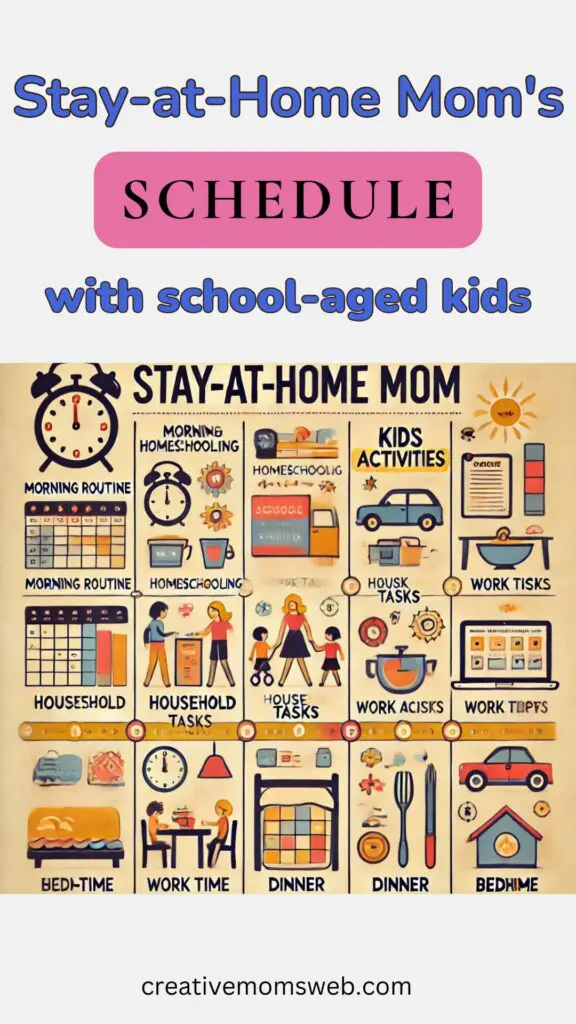The school-age kid is between 6 and 13 years old. These are children who have reached the age to go to school. At this age, some families send their kids to school, while others homeschool them. Being a stay-at-home mom with school-age kids is a fulfilling but challenging job. Managing the household, supporting your children’s education, and taking care of your own well-being can sometimes feel like an overwhelming juggling act. However, by implementing a well-structured schedule, you can bring balance and harmony to your daily routine. In this blog post, we’ll explore an effective stay-at-home mom schedule with school-age kids.

A simple guide on how to create stay-at-home mom schedule with school-age kids
- Rise and Shine:
Start your day early to give yourself a head start. Wake up before your children, allowing you some peaceful moments to prepare yourself mentally and physically for the day ahead. Use this time to enjoy a cup of coffee, practice meditation, exercise, or engage in activities that energize you. Starting the day on a positive note will set the tone for the rest of your schedule.
- Morning Routine:
Once your children wake up, establish a consistent morning routine that encompasses personal hygiene, getting dressed, and having a healthy breakfast together. Encourage your kids to be independent in their morning routine while ensuring they are ready for the day ahead.
- School Time:
Create a dedicated space in your home for your children’s schoolwork. Set aside specific hours for focused learning and academic activities aligned with their school schedule. Help your children with their assignments, review lessons, and provide guidance as needed. Encourage them to complete their tasks independently while being available for any questions or assistance.
- Breaks and Snack Time:
Integrate short breaks and snack time into your schedule to provide your children with mental and physical rejuvenation. Encourage them to take a break from their studies, stretch their legs, and have a nutritious snack. These brief intervals allow them to recharge and maintain their focus throughout the day.
- Enrichment Activities:
Incorporate educational and enrichment activities into your schedule to enhance your children’s learning experience. This can include reading together, engaging in science experiments, conducting art projects, or exploring educational websites and apps. Foster their curiosity and creativity while making learning fun and engaging.
- Lunchtime and Chores:
Plan a designated time for lunch where you can prepare a nutritious meal for your family. Involve your children in age-appropriate kitchen tasks, such as setting the table, preparing simple dishes, or washing vegetables. This not only teaches them practical skills, but also instills a sense of responsibility and teamwork.
- Outdoor Time and Physical Activities:
Allocate time for outdoor play and physical activities. Encourage your children to engage in sports, ride bikes, take nature walks, or participate in other recreational activities. Fresh air and exercise are essential for their overall development, physical health, and mental well-being.
- Personal Time and Self-Care:
Prioritize personal time and self-care to recharge yourself and maintain your own well-being. Dedicate moments in the day to pursue activities that bring you joy and relaxation, such as reading, taking a bath, practicing yoga, or engaging in a hobby. Remember, taking care of yourself enables you to be the best version of yourself for your family.
- Family Time:
Create opportunities for quality family time in the evenings. This can include sharing a meal together, playing board games, reading stories, or having meaningful conversations. Building strong family bonds and connections fosters a nurturing and supportive environment for everyone.
- Bedtime Routine:
Establish a consistent bedtime routine to ensure your children get sufficient rest. Set a specific time for winding down, which may involve reading bedtime stories, having quiet time, or engaging in calming activities. Adequate sleep is vital for their physical and emotional well-being.
A sample of a stay-at-home mom’s schedule with school-age kids that include homeschooling:
Sure! Here’s a table summarizing the stay-at-home mom schedule with school-age kids:
| Time | Activity |
|---|---|
| 6:30 AM – 7:30 AM | Wake up, enjoy quiet time (coffee, reading, or exercise) |
| 7:30 AM – 8:00 AM | Wake kids, get ready (dress, brush teeth) |
| 8:00 AM – 8:30 AM | Family breakfast and connection time |
| 8:30 AM – 12:00 PM | School (for kids) or homeschooling activities |
| 12:00 PM – 12:30 PM | Lunch break |
| 12:30 PM – 2:00 PM | Continue schoolwork or chores for stay-at-home mom |
| 2:00 PM – 3:00 PM | Physical activity or outdoor time |
| 3:00 PM – 4:30 PM | Snack time and free play/quiet activities |
| 4:30 PM – 6:00 PM | Prepare dinner, family time (help kids with tasks like setting the table) |
| 6:00 PM – 7:30 PM | Evening activities (games, family walk, movie) or wind-down time |
| 7:30 PM – 8:30 PM | Bedtime routine (bath, storytime, or getting ready for bed) |
| 8:30 PM – 9:00 PM | Relax and recharge for the mom (read, watch a show, prep for the next day) |
Essential Must-Haves for Stay-at-Home Moms with School-Age Kids
Managing a household, school-going kids, and homeschooling all at once can be overwhelming. But with the right tools and essentials, you can stay organized, save time, and make your daily routine smoother. Here’s a list of must-have Amazon products that can help you balance it all with ease.
🌞 Morning Routine Essentials
A productive day starts with a well-structured morning routine. These essentials will help you get the day started on the right foot.
✅ Coffee Maker – A quick and easy way to get your caffeine fix before the chaos begins.
✅ Planner or Dry Erase Calendar – Keep track of school drop-offs, homeschooling schedules, and meal planning.
✅ Essential Oil Diffuser – Use refreshing scents like citrus or peppermint to boost morning energy.
✅ Alarm Clocks for Kids – Help school-going kids wake up on time and develop independence.
📚 School & Homeschooling Essentials
Whether your kids are attending school or learning from home, these supplies will ensure a smooth learning experience.
✅ Backpacks & Lunchboxes – Keep school kids organized with durable school gear.
✅ Educational Workbooks & Flashcards – Ideal for homeschooling lessons and extra practice for school kids.
✅ Adjustable Kids Desk & Chair – Create a comfortable study space for homeschooling or homework time.
✅ Whiteboard & Markers – Great for homeschooling lessons, to-do lists, and daily schedules.
✅ Noise-Canceling Headphones – Help kids focus during study time or while working on assignments.
✅ Printer & Laminator – Print worksheets and create reusable learning materials for homeschoolers.
🏡 Household & Meal Prep Essentials
Make your household management easier with these time-saving tools.
✅ Slow Cooker or Instant Pot – Prepare meals quickly while juggling other responsibilities.
✅ Grocery Delivery Subscription (Amazon Fresh) – Save time and avoid unnecessary grocery store trips.
✅ Cordless Vacuum Cleaner – Keep your home clean without the hassle of wires.
✅ Meal Prep Containers – Prepare school lunches and snacks in advance.
💻 Work-From-Home & Productivity Essentials
If you’re working from home while managing kids, these essentials will help you stay productive.
✅ Laptop or Tablet – Essential for blogging, remote work, or accessing online homeschooling resources.
✅ Blue Light Blocking Glasses – Protect your eyes from screen time fatigue.
✅ Noise-Canceling Earbuds – Focus on work while kids study, play, or engage in activities.
🎉 Afternoon Play & Extracurricular Essentials
Keeping kids engaged with fun and educational activities is crucial.
✅ Outdoor Play Equipment – Swings, trampolines, or scooters to encourage active play.
✅ STEM Learning Kits – Hands-on science and engineering activities to enhance learning.
✅ Arts & Crafts Supplies – Keep kids busy with creative projects and crafts.
🌙 Evening & Bedtime Essentials
Help your kids wind down and get ready for bed while sneaking in some self-care for yourself.
✅ Bedtime Storybooks & Nightlight – Create a calming bedtime routine.
✅ Bath Bombs & Skincare Set – Pamper yourself after a long day.
✅ Weighted Blanket – Improve sleep quality for both kids and moms.
Do you have a favorite mom essential? Let me know in the comments!
Conclusion:
Crafting a well-structured stay-at-home mom schedule with school-age kids is crucial for maintaining balance and productivity in your daily life. By implementing a routine that prioritizes your children’s education, personal growth, and family time, while also nurturing your own well-being, you can create a harmonious environment for everyone in your household. Remember, flexibility is key, so adjust and refine the schedule as needed to accommodate changing circumstances and evolving needs.
Follow creative moms web on Pinterest


